The aesthetic of the breakdown of reality and the larger truth behind it is what contemporary artist Annie Lapin wishes to achieve through her body of work
I think the way we perceive things and the pleasure we feel when things are tied up with a sense of story, despite its flaws, is astonishing and powerful. It’s definitely part of why I make paintings. The idea of wrapping up chaos in a neat little package that at once seems to make sense and also not make sense – maybe that’s a good description of what I think art does.
Contemporary artist Annie Lapin
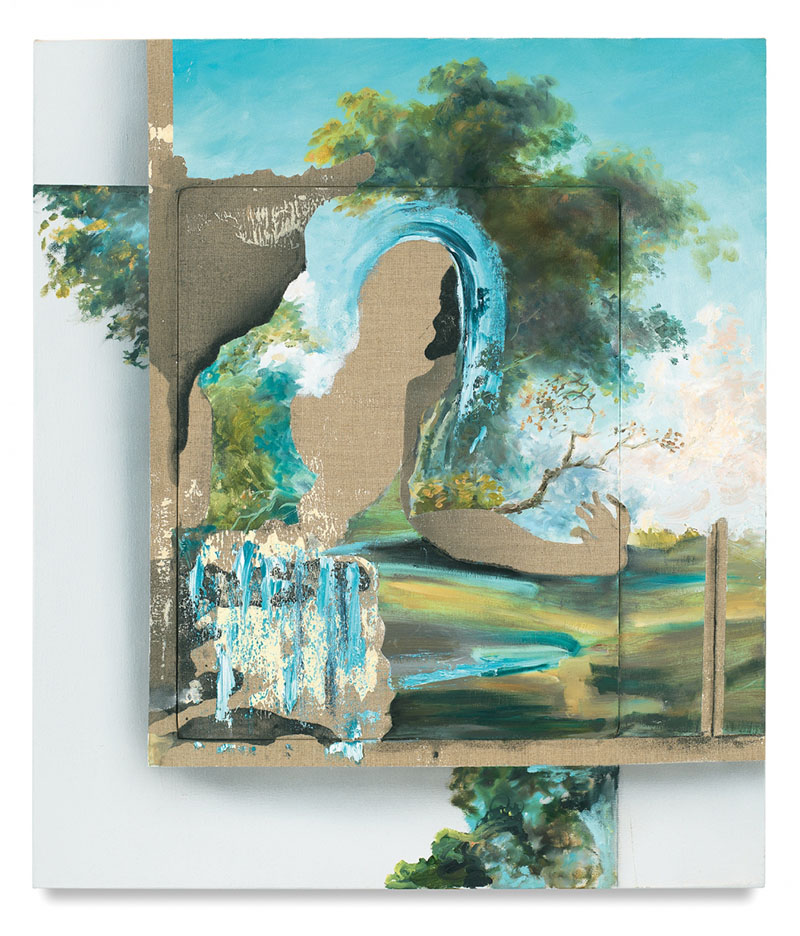
Stop-calling Annie Lapin. Stop Calling, 2018. Oil, acrylic, charcoal and vinyl paint on linen, 36 x 26 inches
How did your tryst with art begin?
Making and thinking for me are inextricably tied together. As a child, however, making was one thing and thinking was another, though they both occupied a lot of my time. I moved from a progressive enclave in Washington DC to a small conservative town in Kentucky, and finally to Tokyo in my teens. As a result of some of this continuous culture shock, I was very sensitive to divergent points of view that people around me had. Since every place had a different view of reality, I would worry about what was really going on in the universe. Would the sun rise tomorrow? What do other people experience? What is true? In the midst of all of this, I was kind of depressed and anxious and liked being alone. This led to a love of making things and a love of looking at things other people made.
When I was in college, I had set out to study archaeology. In my mind, piecing together the world view of another civilisation from historical artifacts felt like it might give way to a type of knowledge I could believe in; whether or not it was correct, it was using the structures of our limited minds to recreate hypothetical structures from another society.
And then I realised that it was a way too lofty goal to have, and that if you wanted to be an archaeologist you really needed to enjoy the tedium and the academic arguments more than I ever could. And somehow in that disillusionment, I discovered that by generating my own images I could engage in the ideas I had wanted to pursue through archaeology; ideas about how the mind is reflected in objects and how communication occurs through artifacts, how understanding is limited by personal and societal history.
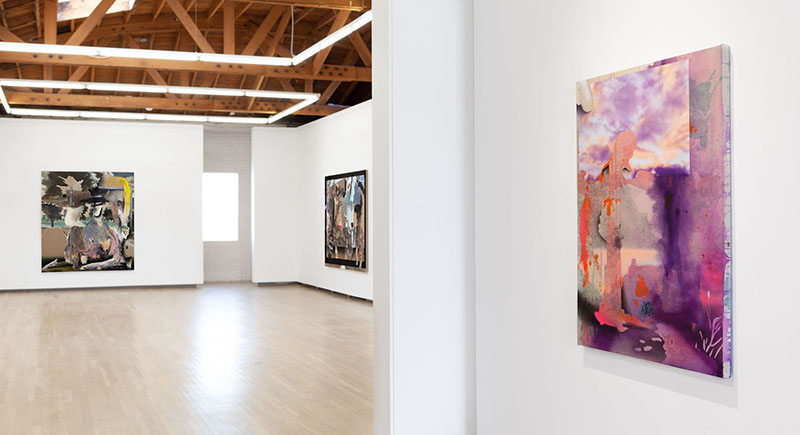
Exhibition view. Strange Little Beast. Contemporary artist Annie Lapin. Shulamit Nazarian Gallery.
What is the primary role of an artist? How do you describe yourself in the context of challenging people’s perspectives via your work and art?
I think the term “artist” and our understanding of that role is so completely mired in historical, economic and societal constructs that I can’t help but mistrust any personal ideas I have about what art making does in a broad sense. It is many things at once and some aspects are painfully shallow, and some are vast and profound. In my own work I’m driven by some basic obsessions, like the drive to make static objects that change as you view them.
I am interested in harnessing optics, mythologies, and an archive of historical and pop cultural imagery most of us carry with us because of the sheer volume of visual information we receive during a lifetime. At my most grandiose, I’d admit that my hope is to make paintings and objects that linger in a certain type of clarity one moment only to dissolve in the next, and in so doing, maybe collectively my works can communicate something about the aesthetic of the breakdown of reality, while simultaneously pointing to a truth beyond the breakdown.
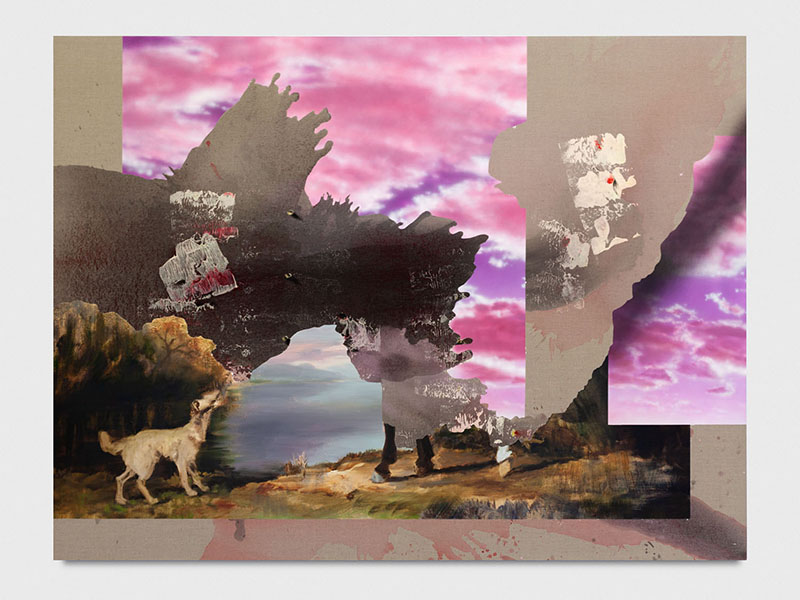
Encounter Counter heap. Contemporary artist Annie Lapin. Shulamit Nazarian Gallery.
Tell us about your commitment to your current medium.
I have experimented with different media, but because my work relies upon illusion so much, painting has been the most expedient way to play with different historical ideas, images, languages, etc.
What inspires you? Take us through your process and continuous frameworks of reference.
The things that continue to feed my work are my interest in cosmology, neuroscience, fields that come to bear on our fundamental understanding of experience or consciousness, as well as art and literature and history. Quantum physics and its contradictions, its implications about how poorly our perceptual apparatuses serve us in creating a picture of what’s really going on, interests me. But also I’m deeply interested in the way that poetry works across societies, and the way we seem to yearn to understand the world in terms of stories, even when stories sometimes aren’t always the most apt form of description.
I think the way we perceive things, and the pleasure we feel when things are tied up with a sense of story, despite its flaws, is astonishing and powerful. It’s definitely part of why I make paintings. The idea of wrapping up chaos in a neat little package that at once seems to make sense and also not make sense – maybe that’s a good description of what I think art does.
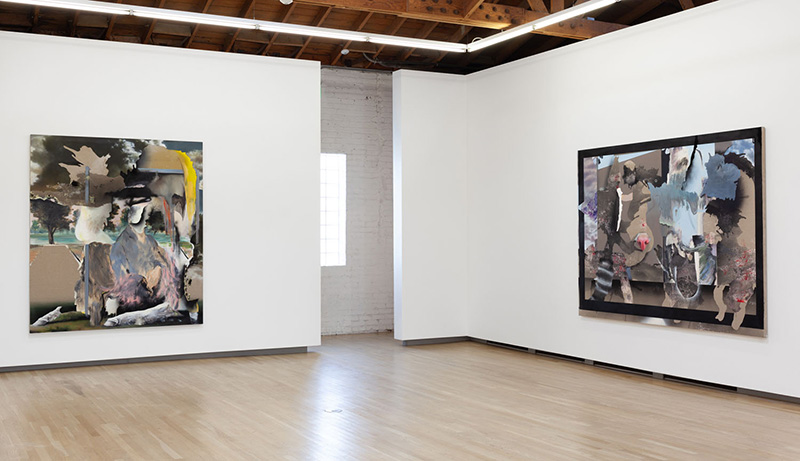
Exhibition view. Strange Little Beast. Shulamit Nazarian Gallery.
Let’s talk about your career, or if you prefer artistic journey. What were your biggest lessons and hurdles? Which is the most memorable moment?
I have definitely always pushed my work in different directions. For better or for worse, trying to make art about the things I’m interested in is not an easy task and I have tried many different angles through painting. But I do think even if various shows ended up shedding light on a narrower slice of a larger conversation in my head, they lead to works that are interesting in their own right… even if not every painting ended up communicating a 100% of everything I was after.
And to that point, I would also add that the paintings really do operate collectively – the breadth of the ideas held in each work is expanded by virtue of its connection to the other paintings I have made. I carefully construct exhibitions to expand a certain kind of language or limit it. I want to establish a certain poetic algorithm, which sometimes allows certain images to arise for the viewer. The paintings in the latest bodies of work rely on unique sets of logic and references for each painting, and jumping from one visual idea to another from one work to another is a big part of how I aim to play with perception as a viewer walks through an exhibition.
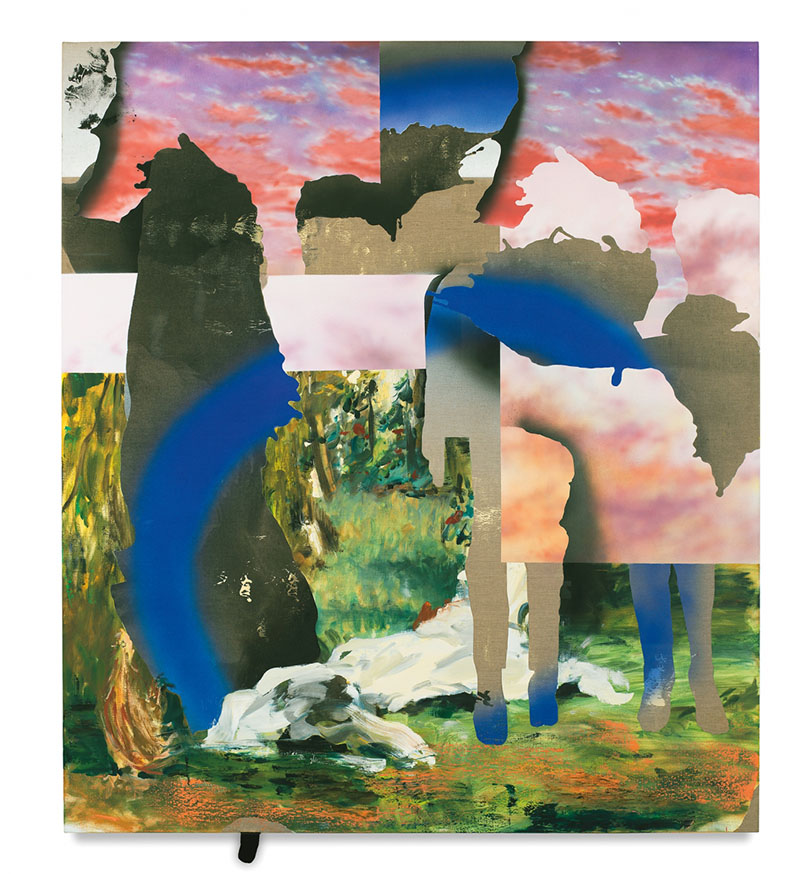
California, Contemporary artist Annie Lapin, 2018. Oil, vinyl paint, acrylic, wool collage, enamel spray paint and charcoal on linen, 82 x 72 inches
How do you balance art and life?
I do not know how to balance art and life, but I do think there is a learning curve and I seem to be getting better at it. I am a recent mother of two. While I never thought my chaotic mind, which always wants to be making work, would be able to adapt to parenting, I actually think motherhood has streamlined my thoughts and helped me focus even more. Taking a pause to be engaged with my children when I am not working is kind of like allowing the art mind to sleep and regenerate. When I come back to the studio my ideas have more clarity. Whatever it is, I think it’s been good for me. It’s a lot of work, but good for my mind.

Catnose. Emergent heap. Contemporary artist Annie Lapin. Shulamit-Nazarian Gallery.
How do you deal with the conceptual difficulty and uncertainty of creating work?
I have come to accept that everything is uncertain and all you can do is keep going. And sometimes it will be painful and sometimes it will be fun.
How does your audience interact and react to your work?
I definitely appreciate it when my audience connects to questions about way they see, why we see what we do, and enjoy the seduction of historical allusions and the viscerality of paint. In the past I would get a little nervous about what the overall effect was because I have certain goals in mind, and transmitting them seems like a very tenuous endeavour. I think sometimes it comes through and sometimes I don’t know what comes through. But these days, I have a sense that the painting in its latest form is firing all of the right cylinders for more people than before, and that feels like a success.
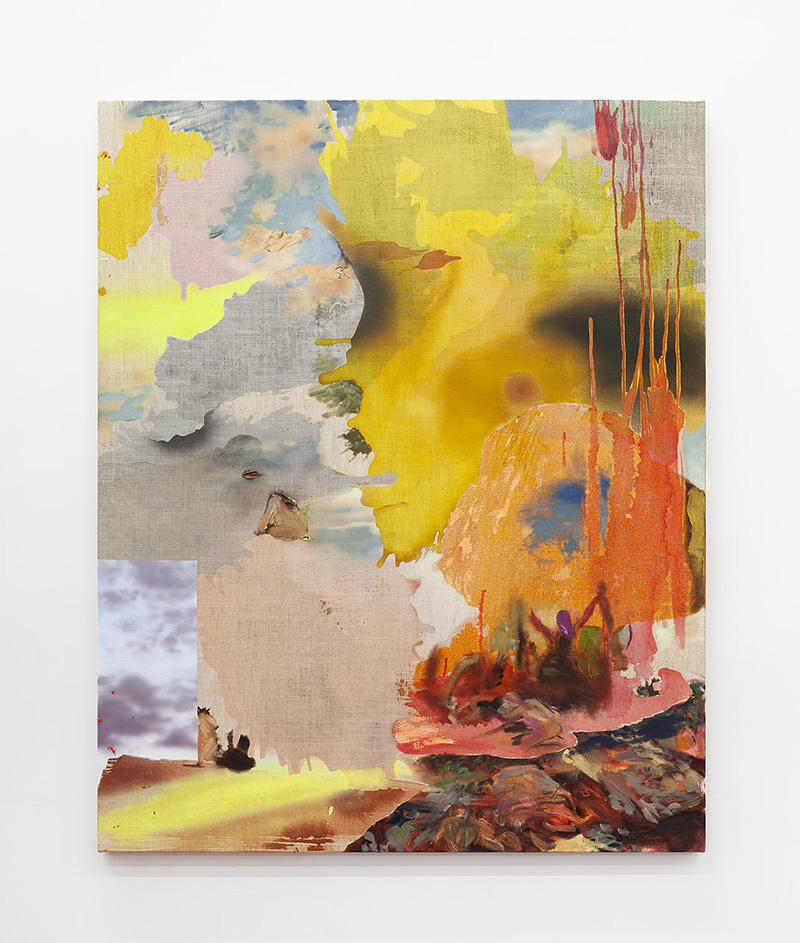
Inter Reaction (StepScape 2), Contemporary artist Annie Lapin, 2019. Oil, acrylic and vinyl paint on linen, 52 x 42 inches. Shulamit Nazarian Gallery.
You have spent time amongst artists in flow, what have you observed?
I don’t think I fully came to appreciate what I love about great art until I started teaching enough to really think about what studio art lacked and where it needed to go. Specifically, I came to see work by the artists that I think are important as having three qualities:
1) The artist went down an extremely idiosyncratic rabbit hole of their own visual / narrative / executive logic, and they went so deep that the viewer can look at that, see something that makes sense but remains mysterious, weird, exhilaratingly absurd.
2) The art represents different aspects of a powerful personal vision.
3) The art (by chance or by design) reflects its own time without simply mimicking forms that fall into the fashion of its time.
Before you go – you might like to browse our Artist Interviews. Interviews of artists and outliers on how to be an artist. Contemporary artists on the source of their creative inspiration.








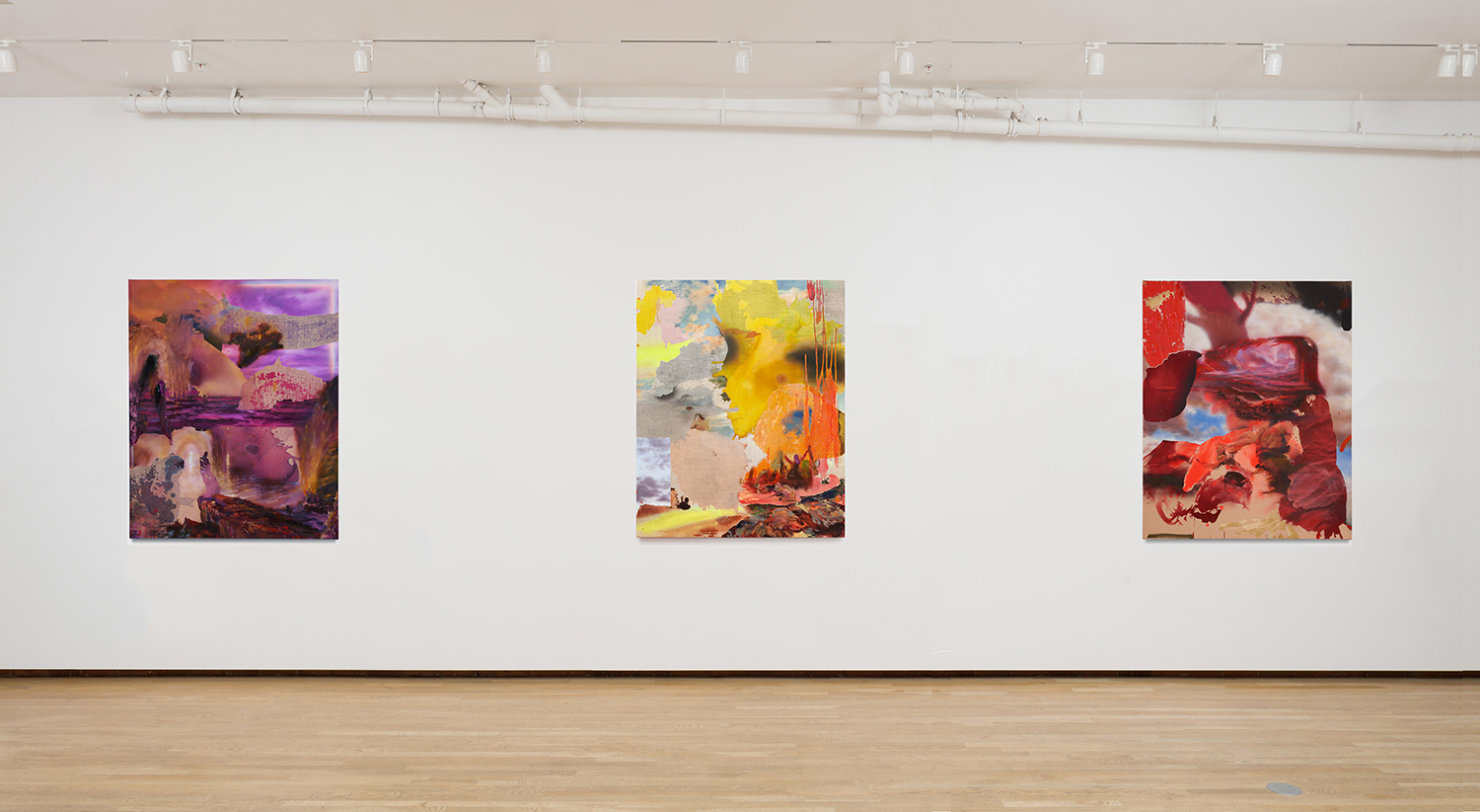



Add Comment